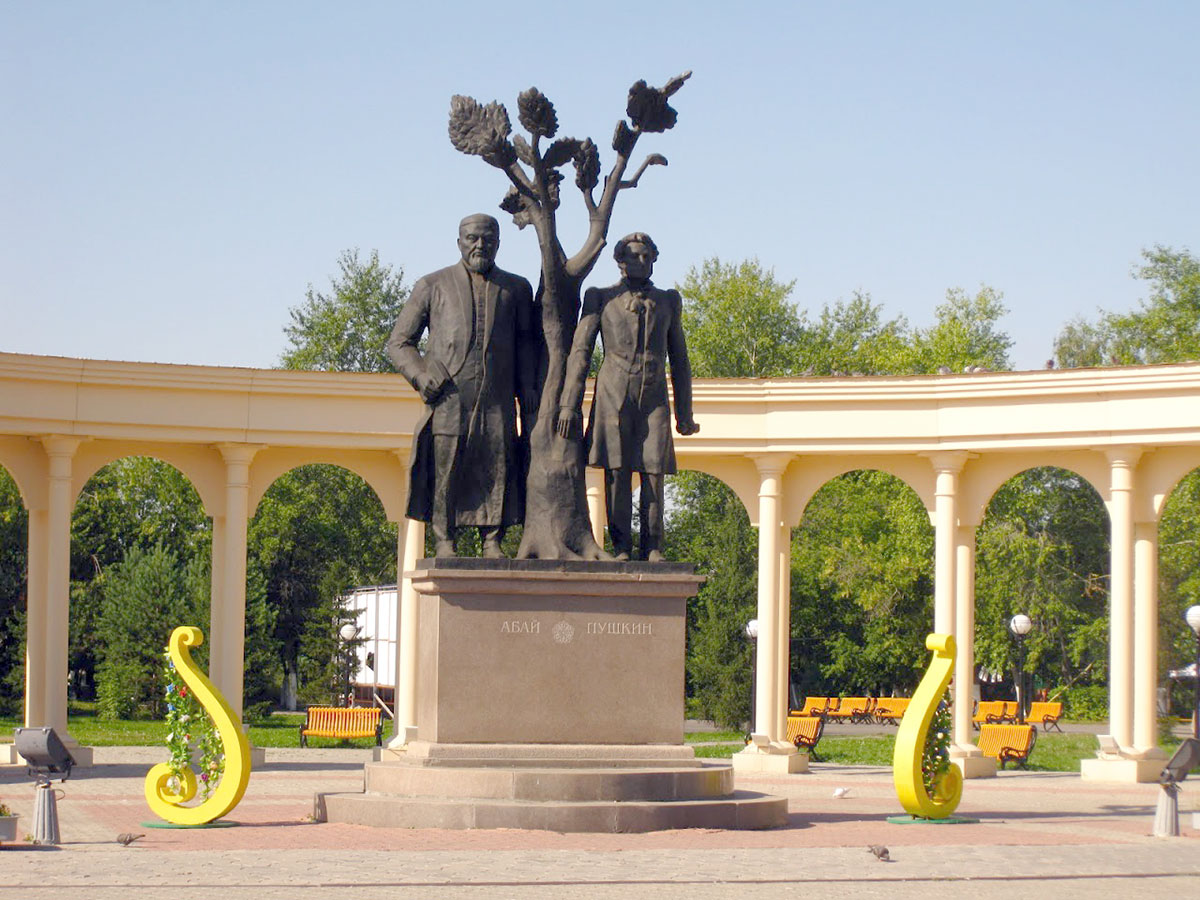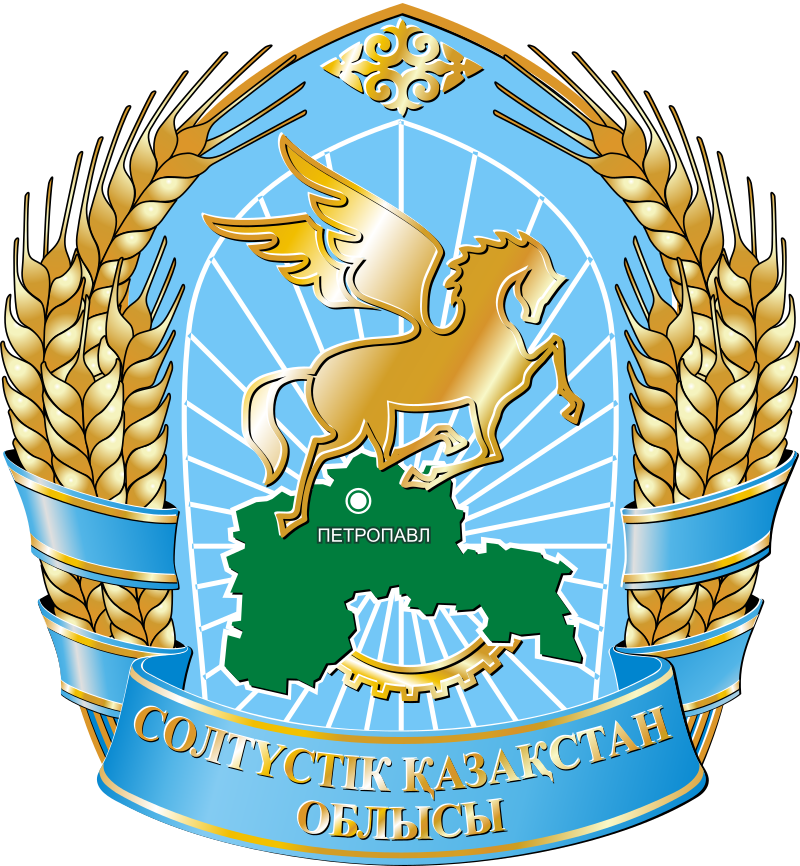North Kazakhstan oblast

Мой Казахстан
North Kazakhstan oblast

Geography
North Kazakhstan oblast is located in the north of Kazakhstan, occupies the southern edge of the West Siberian Plain and part of the Kazakh hillocky area (Sary-Arka). It borders in the north with the Kurgan, Tyumen and Omsk oblasts of Russia, in the southeast — with Pavlodar oblast, in the south — with Akmola oblast, in the west — with Kostanai oblastю
The territory of the oblast is 97,993 km2 and makes up 3.6% of the territory of Kazakhstan. The distance in a straight line between the extreme points in the north —south direction is 375 km, west — east is 602 km. The coordinates of the extreme northern point are 55°26’N and 68°59’E, the extreme southern point is 52°13’N and 67°E, the extreme western point is 54°N and 65°57’E, the extreme eastern point is 52°50’N and 74°02’E.
Zhaksy-Zhalgyztau mountain is in the south (748 m) — the highest point of the oblast, the lowest point is Teke Lake located in the east of the oblast (28 m).
Hydrography
Rivers belong to the Ob basin. The territory of the oblast is crossed almost in the meridional direction by the valley of Ishim River (with tributaries - Imanburlyk and Akkanburlyk), the width of which varies from a few kilometers in the south to 20-22 km in the north of the oblast.
There are 3,425 basins of existing and disappeared lakes on the territory of the oblast. In terms of the area of the water mirror, the largest of them are Siletyteniz (777 km2), Teke (265 km2), Shagalalyteniz (240 km2), Kishi-Karaoi (102 km2). The basins of such lakes as Siverga, Mengiser, Stanovoye, Bolshoy Tarangul (Tarankol) have an area of 30-50 km2 or more. Quantitatively, lakes and lake basins with areas of about 1 km2 predominate. Lakes of Kokshetau upland are distinguished by the greatest depths: Shalkar — 15 m, Zhaksy-Zhalgyztau — 14.5 m, Imantau — 10 m; lakes with depths less than 3-5 m prevail. On Ishim River in the territory of the oblast there is a Sergeyevsky reservoir with an area of about 117 km2.
On the territory of the oblast, Bulaevsky water pipeline with a length of 1,694 km has been laid, providing water to settlements and used for watering agricultural lands.
Climate
The climate is extremely continental, belongs to the West Siberian climatic region of the temperate zone. Winters are cold and long, summers are relatively hot, with clear, often arid weather prevailing. The average temperature in January is -18.6°C, in July +19.0°C. The lowest air temperatures are about -48°C (Bulayevo station, 1968), the highest are about +41°C (Sergeyevka city, 2014). The duration of the period with average daily temperatures above 0°C is on average 125 days. The average date of temperature transition through 0°C is April 10-15, through +5°C — April 22-25.
History
Tribes of the Middle Zhuz lived on the territory of the North Kazakhstan oblast in the 19th century: Argyns (Atygai, Karauyl, Kanzhygaly families), Kerei (Kursars, Aksars), Kypshak (Kulan), Bultyn-Kypshakuaks.
One of the significant stages of resettlement in the territory of modern North-Kazakhstan oblast occurred at the late XIX — early XX centuries and is primarily associated with the opening of the Siberian Railway and the Stolypin agrarian reform. It was during this period that the foundation of the Ukrainian community in Kazakhstan was laid.
According to the results of these migrations, Ukrainians made up the majority of the population of the northern regions of Kazakhstan in the vast territory of the Steppe Region, referred to in historiography as the Gray Wedge.
In 1921-1928 Petropavlovsk was the center of Akmola province of Kirgizskaya ASSR (since 1925 — Kazakhskaya ASSR).
In early 20s of the XX century, the West Siberian Uprising was suppressed by the Reds - the largest anti-Bolshevik armed uprising of peasants, qazaq, part of the workers and urban intelligentsia in the RSFSR.
North Kazakhstan oblast was formed from the northern districts of Karaganda oblast and Karkarala district by the Decree of the Central Executive Committee of July 29, 1936.
By the Decree of the Presidium of the USSR Supreme Soviet of October 14, 1939, Stepnyak ccity and 11 southern districts (Aryk-Balyksky, Atbasarsky, Zerendinsky, Yessilsky, Kalininsky, Makinsky, Molotovsky, Ruzaevsky, Stalinsky, Shchuchinsky and Yenbekshildersky) were transferred to the newly formed Akmola oblast.
It was awarded the Order of Lenin on October 28, 1966.
As a result of the administrative and territorial reform of 1997, a number of districts of the abolished Kokchetavskaya oblast were included in North Kazakhstan oblast (modern Aiyrtau (the regional center is Saumalkol village - former Volodarskoye), Leninsky (the regional center is Talshik village), Gabit Musrepov district (the regional center is Novoishimskoye village), Taiynshinsky (the regional center is Taiynsha city — former Krasnoarmeysk) and Ualikhanov districts (the regional center is Kishkenekol village — former Kzyltu) with a large proportion of the Kazakh population. The structure of North Kazakhstan oblast in the old borders (until 1997) included modern districts: Akkaiynsky district (the regional center is Smirnovo village), Yessilsky (the regional center is Yavlenka), Zhambylsky (the regional center is Presnovka village), Bulayevsky district (the regional center is Bulaevo city), Vozvyshensky district (the regional center is Vozvyshenka), Kyzylzharsky (the regional center is Bishkul village), Mamlyutsky (the regional center is Mamlyutka city), Timiryazevsky (the regional center is Timiryazevo village), Shal Akyn district (the regional center is Sergeyevka city), in which the Russian population mainly currently lives.
Administrative division
Administrative map of the oblast
The oblast is divided into 13 districts and 1 city of regional significance — Petropavlovsk city:
Aiyrtau district — the regional center is Saumalkol village
Akzhar district — the regional center is Talshik village
Akkaiyn district — the regional center is Smirnovo village
Yessilsky district — the regional center is Yavlenka village
Zhambyl district — the regional center is Presnovka village
Magzhan Zhumabayev district — the regional center is Bulayevo village
Kyzylzhar district — the regional center is Bishkul village
Mamlyutsky district — the regional center is Mamlyutka city
Gabit Musrepov district — the regional center is Novoishimskoye village
Taiynshinsky district — the regional center is Taiynsha
Timiryazevsky district — the regional center is Timiryazevo villlage
Ualikhanov district — the regional center is Kishkenekol
Shal Akyn district — the regional center is Sergeyevka city
Petropavlovsk
Number of cities — 5.
The number of rural districts is 190.
The number of villages is 689.
Contacts



